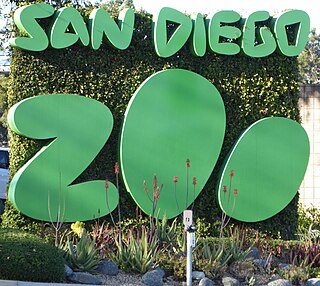
The San Diego Zoo is a zoo in Balboa Park, San Diego, California, housing over 12,000 animals of more than 650 species and subspecies on 100 acres (40 ha) of Balboa Park leased from the City of San Diego. Its parent organization, San Diego Zoo Wildlife Alliance, is a private nonprofit conservation organization, and has one of the largest zoological membership associations in the world, with more than 250,000 member households and 130,000 child memberships, representing more than a half million people.

The Panama–California Exposition was an exposition held in San Diego, California, between January 1, 1915, and January 1, 1917. The exposition celebrated the opening of the Panama Canal, and was meant to tout San Diego as the first U.S. port of call for ships traveling north after passing westward through the canal. The fair was held in San Diego's large urban Balboa Park.

Katherine Olivia "Kate" Sessions was an American botanist, horticulturalist, and landscape architect closely associated with San Diego, California, and known as the "Mother of Balboa Park."
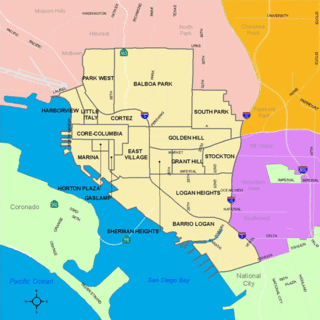
Golden Hill is a neighborhood of San Diego, California. It is located south of Balboa Park, north of Sherman Heights/Highway 94, and east of Downtown.

The San Diego Natural History Museum is a museum located in Balboa Park in San Diego, California. It was founded in 1874 as the San Diego Society of Natural History. It is the second oldest scientific institution west of the Mississippi and the oldest in Southern California. The present location of the museum was dedicated on January 14, 1933. A major addition to the museum was dedicated in April 2001, doubling exhibit space.
Victory Boulevard is a major east-west arterial road that runs 25 miles (40 km) traversing the entire length of the San Fernando Valley in Los Angeles County, Southern California, United States.

San Diego Zoo Wildlife Alliance is a not-for-profit organization headquartered in San Diego that operates the San Diego Zoo and the San Diego Zoo Safari Park. Founded in 1916 as the Zoological Society of San Diego under the leadership of Harry M. Wegeforth, the organization claims the largest zoological society membership in the world, with more than 250,000 member households and 130,000 child memberships, representing more than half a million people. The organization's mission is to save species worldwide by uniting their expertise in animal care and conservation science with their dedication to inspiring passion for nature.
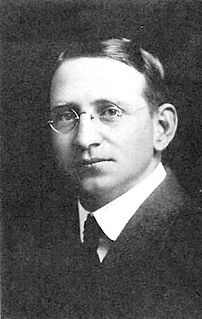
Harry Milton Wegeforth was an American physician who founded the Zoological Society of San Diego and the San Diego Zoo. As a doctor he operated a thriving practice in San Diego, served briefly as president of the City Board of Health and as a surgeon for the San Diego and Arizona Railway, and established a hospital and clinic in the city's downtown district. He is best known, however, for founding the Zoological Society, which grew out of his involvement with the Panama–California Exposition in 1916, and for being the driving force behind the creation and early growth of the Zoo.

The George W. Marston House, or George Marston House and Gardens, also referred to as the George and Anna Marston House or the Marston House, is a museum and historic landmark located in San Diego and maintained by Save Our Heritage Organisation (SOHO).

Switzer Canyon is a canyon in San Diego, California. It is situated to the east of Balboa Park and serves as the boundary between the neighborhoods of North Park and South Park in Central San Diego. Switzer Canyon remains an oasis of natural vegetation between some of the city's most urban neighborhoods and is a prime example of San Diego county's unique canyon-laced topography.

Balboa Park is a 1,200-acre (4.9 km2) historic urban cultural park in San Diego, California, United States. In addition to open space areas, natural vegetation zones, green belts, gardens, and walking paths, it contains museums, several theaters, and the San Diego Zoo. There are also many recreational facilities and several gift shops and restaurants within the boundaries of the park. Placed in reserve in 1835, the park's site is one of the oldest in the United States dedicated to public recreational use. Balboa Park is managed and maintained by the Parks and Recreation Department of the City of San Diego.

The Japanese Friendship Garden, also known as Sankei-en is a twelve-acre Japanese garden located within Balboa Park in San Diego, California. It is an expression of friendship between San Diego and its Japanese sister city Yokohama that binds the two cultures to create a unique experience for visitors from all over the world; over 240,000 people from across the United States and the world visit the garden annually. Representing a new concept in the development of a Japanese garden outside Japan, the Japanese Friendship Garden is designed to present an atmosphere of elegant simplicity (shibui) and quiet beauty. The garden's naturalistic design is guided by the original principles/techniques of the Japanese garden while incorporating elements of the regional San Diego landscape and climate; in terms of features, the garden is well-known for its unique placement, sukiya-style buildings, koi ponds, and landscape exhibits. The Japanese Friendship Garden also hosts many local educational programs, activities, festivals, and horticultural classes that focus on the relationship between nature and Japanese culture.

Zoro Garden is a 6-acre sunken garden within Balboa Park in San Diego, California. It is located between the Reuben H. Fleet Science Center and the Casa de Balboa. The name refers to the Persian mystic Zoroaster.
Alfred D. Robinson (1866–1942) and his wife Marion James Robinson (1873–1919) were wealthy residents of San Diego, California known for their impact on gardening and the cultivation of flowers, particularly begonias. Their extensive home garden was used to propagate and develop more than 100 new varieties of ornamental flowers and was later opened to the public as Rosecroft Begonia Gardens. Rosecroft was the name of their estate in the Point Loma neighborhood of San Diego. The residence, built for them in 1912, is now listed on the National Register of Historic Places.

The El Prado Complex is a historic district in Balboa Park in San Diego, California. The 13-acre (5.3 ha) complex includes 13 contributing buildings and one contributing structure. Most of the structures were built for San Diego's Panama-California Exposition of 1915–16 and were refurbished and re-used for the California Pacific International Exposition of 1935–36. The original architects were Bertram Goodhue and Carleton Winslow. The area was listed on the National Register of Historic Places in 1976.
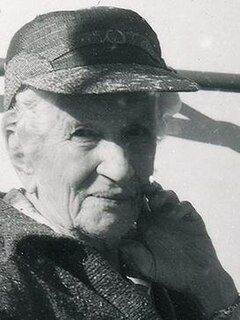
Ethel Bailey Higgins was an American botanist and the curator of botany at the San Diego Natural History Museum from 1943 to 1957; she continued to serve as associate curator from 1957 to 1963. Higgins authored Our Native Cacti (1931), and other popular works on plants of the southwestern United States and northern Mexico.
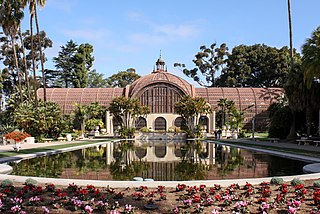
The Botanical Building is an historic building located in San Diego's Balboa Park, in the U.S. state of California. Built for the 1915–16 Panama–California Exposition, it remains one of the largest lath structures in the world. Alfred D. Robinson (1867–1942), founder and president of the San Diego Floral Society, suggested the construction of a lath house as a feature of the Panama–California Exposition, which was to open in the City of San Diego on January 1, 1915.
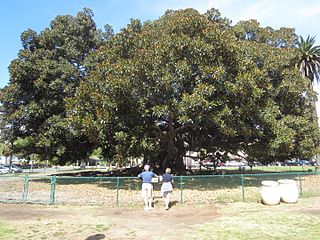
The Moreton Bay fig tree in San Diego's Balboa Park is one of the largest trees in California.






















